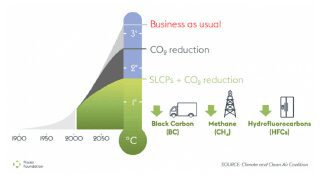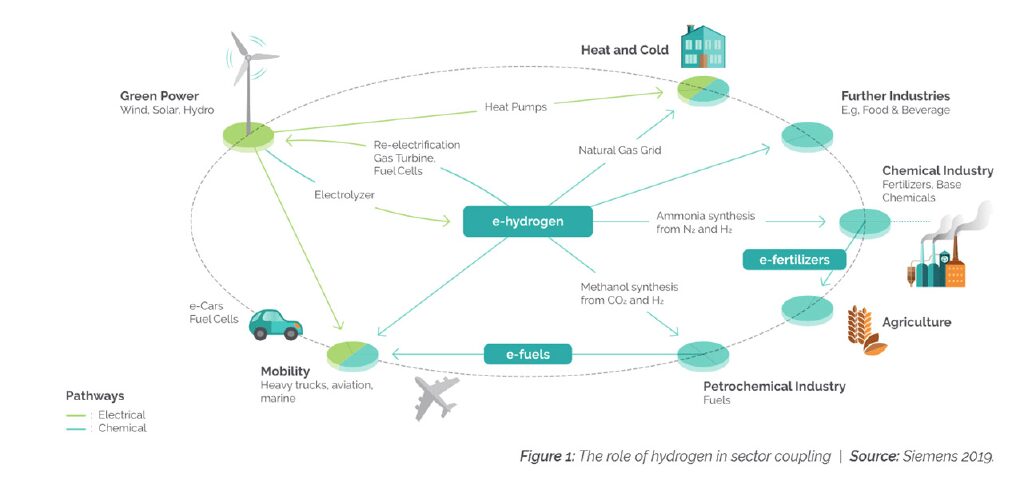Fast soot reduction from household energy and transport globally should be our number one priority if we put public health and nature’s health at the core of our investment decisions. In many African countries, millions of women are still cooking on wood, and millions of people often drive 100 – 150 km/day on fossil motorbikes. Fast electrification of rural areas and growing cities is needed. So how can we get healthy energy without any soot emissions when generating it to the people? Maybe nature holds the answer? In this article we will show how the production and usage of healthy hydrogen in Africa made from abundant sun, wind and local biomass, holds the potential to contribute to reduction of global warming in the short run while substantially improving air quality in Africa and in Europe. We will give an example of how a partnership between North and South could be a win-win for both.
Why should we eliminate diesel, gas and biomass combustion as much as we can?
“If we reduce emissions from domestic furnaces and diesel cars as much as we can, we could achieve half a degree less warming, or a few decades of delay” (Professor Pieter Forster, , co-author of NASA report. This is because the impact of reducing 1 ton of black carbon (soot) during one week, has the same effect of reducing 1.000 to 2.000 tons of carbon-dioxide (CO2) over a 100 years or even 4.000 tons of carbon-dioxide over a 20-year period (Shindell, 2012). According to the WHO (2021), this strategy has the co-benefit that it will also improve our health and save millions of premature deaths, many of which are children younger than 5 years old. This is mostly in developing countries where mainly women are still utilizing woodstoves to cook (WHO, 2021).
What is the general situation of energy development?
Solar plants and wind farms to generate green electricity are planned to create vast amounts of green electricity, both for direct use and export, or to be used as a feedstock for the creation of green hydrogen. Green hydrogen plays a key role in accelerating the shift of the world towards clean energy and mobility. It is impossible to decarbonise our industry, our household energy, our transport, and our gas networks without green hydrogen. It must be stressed that hydrogen is an energy carrier, that just like helium, does not exist naturally on our planet. It is such a light and small molecule that it immediately escapes into the cosmos. Therefore, large infrastructure is planned to transport this green energy and this green hydrogen. Green hydrogen can also be generated from local biomass such as the water hyacinth.

What is the future perspective with energy and hydrogen contributions world?
There are several ways to produce hydrogen, ranging from very carbon intensive to Zero Carbon, or even less when made from biomass and the renewable CO2 is captured and stored or is used as a feedstock for making renewable gas. We define ‘healthy hydrogen’ as hydrogen that is healthy for the people and healthy for our planet and leads us to a fast track of slowing down global warming. With a focused approach towards healthy hydrogen, we can generate healthy electricity, healthy gas (by combining it with carbon) and it can even directly produce heat with an efficiency of 90%. It allows for clean cooling as well.
How could hydrogen be considered for future development in Energy solutions in Africa?
The impact of reducing black carbon and methane on the African continent is the largest in Central Africa. On the other hand, Africa has abundance of sun, wind, even municipal waste and water hyacinth that can be used to produce hydrogen. Africa has access to some of the minerals that are used in hydrogen fuel cells. There is abundance of space and greenfield, as well as a tremendous opportunity for decentralized energy generation. Its population is young, and megacities are needed, so it can take a quantum leap in the development of circular megacities that convert their own waste into energy and generate locally as much energy as possible. And it has a young population ready to be trained on this new emerging market of healthy hydrogen both for the domestic market as well as for the export market. Imagine the impact of carbon pricing in getting to net zero.
Carbon pricing has an important role to play in helping jurisdictions and companies achieve net zero emissions. Commitments to phase out fossil fuel financing, mounting public pressure for the financial sector to stop supporting brown energy, and increased carbon risk disclosure requirements from regulators are collectively driving more financial managers to assess their portfolios’ exposure to a range of transition risks. Carbon pricing also offers financial managers a tool to engage investees and clients on the potential financial impact of their carbon footprints, translating abstract emissions data into bottom-line figures that decision-makers—both within and outside the organization.
Which effect could be expected from using healthy hydrogen in Africa?
Africa could kickstart the healthy hydrogen market by developing its domestic market over the whole continent and show Europe, and other megacities, how to grow sustainably within the planetary boundaries whilst respecting the 17 UN SDG’s. Because of its abundance of energy sources to produce healthy hydrogen, Africa will be able to produce it in a very cost-efficient manner. It could be safely stored in small containers that create healthy hydrogen on demand. Imagine that the millions of two-wheel motors would be replaced by two-wheelers that are very robust and can easily swap their containers. Bikers would pay on a km basis so that CAPEX is low. Imagine a finance scheme is keeping the operation cost down for the drivers because the North is paying the South for each clean km. Along with this – clear skies, healthy children and slowing down global warming are just a few of the effects we can image. The platform of Little Lilly wants to enable such business models.
News and energy trends in Africa need healthy hydrogen
Africa is recognized as an energy poor continent in which most people from Sub-Saharan Africa live in severe energy poverty, which impacts negatively on their economic development. Despite this, north African countries and South Africa are major exceptions with significantly higher levels of electrification and overall energy consumption, to meet the current and future energy demand poses a major challenge in all African countries (Quitzow, Roehrkasten, Jacobs, & Bayer, 2016).
The data reported by IRENA on the African energy sector in 2012 speaks volumes. Biomass and residues covered about 50% of Africa’s energy supply, but on obsolete technologies, with low energy efficiencies and that weigh on the health and quality of life of the inhabitants due to the associated indoors emissions. Although in North Africa, 98% of access to electricity was reached, the west and the south of Africa only reached 47 and 43% respectively, whilst the center and the east of the contingent give access to 25 and 23% in that order. Even though in South Africa, the per capita consumption is 2060 kWh a-1 p-1, 57% of the population does not have access to electricity, which shows energy inequality, even in the regions with the highest consumption (IRENA, 2015).
The perspectives in the African energy sector are oriented to the use of the enormous potential of existing renewable energies, considering different technologies such as geothermal, photovoltaic solar, thermal solar etc. – until reaching 10 GW of capacity (Quitzow, Roehrkasten, Jacobs, & Bayer, 2016). In this sense, the traditional use of biomass is expected to decrease by 66%, while its use with advanced technologies will increase by 86% by 2030 (IRENA, 2015).
In the research carried out by experts and specialized institutions, the use of hydrogen as an alternative for the production and storage of energy is not considered, even though several technologies are currently available worldwide to transform biomass and other types of waste into hydrogen. This could be used for food cooking and transportation, as well as for storing energy, with a significant positive impact on CO2 emissions and user health. Reaching the renewable energy objectives proposed by the African continent will require working in different directions – the first being the formulation of development policies and strategies that include the introduction of renewable energy technologies, in all the holistic aspects of development, and especially the development in rural areas. The second will be to work on the creation of financing mechanisms and material assurance to achieve the policy objectives, since the region lacks effective financial mechanisms in general. The promotion of renewable energies in Africa should pay special attention to the training of human resources, especially highly qualified personnel for design, innovation and technological development, as well as professional training for the operation and maintenance of the energy facilities.
In general, the continent should also emphasize the development of institutional capacities and entrepreneurship at all levels of society. Africa is at a time of change in its energy structure that will, upon relying on renewable energies, allow it to reduce the environmental impact of CO2 emissions, increase access to electricity for the population whilst contributing to rural development and the creation of employment through the energy sector.
For Africa, it would be a mistake not to include the use of hydrogen for cooking, transportation and energy storage in its energy transformation strategy from the outset, thus contributing to the reduction of global warming. After IRENA, “if hydrogen is deployed at scale, this can have significant implications for the power sector, and it opens up additional opportunities for renewable power deployment” (IRENA., 2019).
Hydrogen is considered to be a bridge between Africa and Europe. Europe expects to have 40 GW capacity of electrolyzer installed by 2030, as well as other 40 GW outside of Europe, part of them being in the north of Africa (Matthes, Aruffo, & Retby-Pradeau, 2020). However, the true and most necessary hydrogen bridge should connect the entire African continent in the use of the hydrogen technology to help reduce the environmental impact of the energy sector, whilst improving the living conditions and access to energy of the African population. The importance of hydrogen for the coupling of the sectors is summarized in the following graph produced by Siemens, cited by (Matthes, Aruffo, & Retby-Pradeau, 2020) and shows the elements of a strategy that must be considered for the energy future of Africa.

Co-authors
Alexandra Lybaert, Founder LittleLillyWorld
Samuel Adunreke Founder, Innovea Hubs
Prof. Dr. C. Ing. Osvaldo Romero Romero – Professor SRH – Hochschule Berlin
Director of the Master’s Program in Engineering and International Business, with Focus on Renewable Energies, Waste and Water Management























